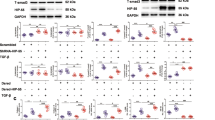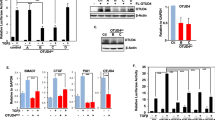Abstract
Smad7 negatively regulates transforming growth factor (TGF)-β superfamily signaling by binding to activated type I receptors, thereby preventing the phosphorylation of receptor-regulated Smads (R-Smads), as well as by recruiting HECT-type E3 ubiquitin ligases to degrade type I receptors through a ubiquitin-dependent mechanism. To elucidate the regulatory mechanisms of TGF-β signaling, we searched for novel members of proteins that interact with Smad7 using a yeast two-hybrid system. One of the proteins identified was the WW domain-containing protein 1 (WWP1) that is structurally related to Smad ubiquitin regulatory factors (Smurfs), E3 ubiquitin ligases for Smads and TGF-β superfamily receptors. Using a TGF-β-responsive reporter in mammalian cells, we found that WWP1 inhibited transcriptional activities induced by TGF-β. Similar to Smurfs, WWP1 associated with Smad7 and induced its nuclear export, and enhanced binding of Smad7 to TGF-β type I receptor to cause ubiquitination and degradation of the receptor. Consistent with these results, WWP1 inhibited phosphorylation of Smad2 induced by TGF-β. WWP1 thus negatively regulates TGF-β signaling in cooperation with Smad7. However, unlike Smurfs, WWP1 failed to ubiquitinate R-Smads and SnoN. Importantly, WWP1 and Smurfs were expressed in distinct patterns in human tissues and carcinoma cell lines, suggesting unique pathophysiological roles of WWP1 and Smurfs.
This is a preview of subscription content, access via your institution
Access options
Subscribe to this journal
Receive 50 print issues and online access
$259.00 per year
only $5.18 per issue
Buy this article
- Purchase on Springer Link
- Instant access to full article PDF
Prices may be subject to local taxes which are calculated during checkout









Similar content being viewed by others
References
Arteaga CL, Tandon AK, Von Hoff DD and Osborne CK . (1988). Cancer Res., 48, 3898–3904.
Attisano L and Wrana JL . (2000). Curr. Opin. Cell. Biol., 12, 235–243.
Bonni S, Wang HR, Causing CG, Kavsak P, Stroschein SL, Luo K and Wrana JL . (2001). Nat. Cell Biol., 3, 587–595.
Brummelkamp TR, Bernards R and Agami R . (2002). Science, 296, 550–553.
Conkright MD, Wani MA and Lingre JB . (2001). J. Biol. Chem., 276, 29299–29306.
Dan S, Tsunoda T, Kitahara O, Yanagawa R, Zembutsu H, Katagiri T, Yamazaki K, Nakamura Y and Yamori T . (2002). Cancer Res., 62, 1139–1147.
Derynck R, Zhang Y and Feng X-H . (1998). Cell, 95, 737–740.
Ebisawa T, Fukuchi M, Murakami G, Chiba T, Tanaka K, Imamura T and Miyazono K . (2001). J. Biol. Chem., 276, 12477–12480.
Ebisawa T, Tada K, Kitajima I, Tojo K, Sampath TK, Kawabata M, Miyazono K and Imamura T . (1999). J. Cell Sci., 112, 3519–3527.
Flasza M, Gorman P, Roylance R, Canfield AE and Baron M . (2002). Biochem. Biophys. Res. Commun., 290, 431–437.
Frolik CA, Wakefield LM, Smith DM and Sporn MB . (1984). J. Biol. Chem., 259, 10995–11000.
Fukuchi M, Fukai Y, Masuda N, Miyazaki T, Nakajima M, Sohda M, Manda R, Tsukada K, Kato H and Kuwano H . (2002). Cancer Res., 62, 7162–7165.
Fynan TM and Reiss M . (1993). Crit. Rev. Oncol., 4, 493–540.
Hanyu A, Ishidou Y, Ebisawa T, Shimanuki T, Imamura T and Miyazono K . (2001). J. Cell Biol., 155, 1017–1028.
Heldin C-H, Miyazono K and ten Dijke P . (1997). Nature, 390, 465–471.
Huang K, Johnson KD, Petcherski AG, Vandergon T, Mosser EA, Copeland NG, Jenkins NA, Kimble J and Bresnick EH . (2000). Gene, 252, 137–145.
Imamura T, Takase M, Nishihara A, Oeda E, Hanai J, Kawabata M and Miyazono K . (1997). Nature, 389, 622–626.
Kavsak P, Rasmussen RK, Causing CG, Bonni S, Zhu H, Thomsen GH and Wrana JL . (2000). Mol. Cell, 6, 1365–1375.
Kawabata M, Inoue H, Hanyu A, Imamura T and Miyazono K . (1998). EMBO J., 17, 4056–4065.
Kleeff J, Ishiwata T, Maruyama H, Friess H, Truong P, Buchler MW, Falb D and Korc M . (1999). Oncogene, 18, 5363–5372.
Koinuma D, Shinozaki M, Komuro A, Goto K, Saitoh M, Hanyu A, Ebina M, Nukiwa T, Miyazawa K, Imamura T and Miyazono K . (2003). EMBO J., 22, 1–13.
Li CY, Suardet L and Little JB . (1995). J. Biol. Chem., 270, 4971–4974.
Lin X, Liang M and Feng X-H . (2000). J. Biol. Chem., 275, 36818–36822.
Maeda S, Hayashi M, Komiya S, Imamura T and Miyazono K . (2004). EMBO J., 23, 552–563.
Massagué J, Blain SW and Lo RS . (2000). Cell, 103, 295–309.
Miyazawa K, Shinozaki M, Hara T, Furuya T and Miyazono K . (2002). Genes Cells, 7, 1191–1204.
Murakami G, Watabe T, Takaoka K, Miyazono K and Imamura T . (2003). Mol. Biol. Cell, 14, 2809–2817.
Ota T, Fujii M, Sugizaki T, Ishii M, Miyazawa K, Aburatani H and Miyazono K . (2002). J. Cell. Physiol., 193, 299–318.
Pirozzi G, McConnell SJ, Uveges AJ, Carter JM, Sparks AB, Kay BK and Fowlkes DM . (1997). J. Biol. Chem., 272, 14611–14616.
Roberts AB and Sporn MB . (1990) In Sporn MB and Roberts AB (eds). Peptide Growth Factors and Their Receptors, Part I. Springer-Verlag: Heidelberg, pp. 419–472.
Schwarz SE, Rosa JL and Scheffner M . (1998). J. Biol. Chem., 273, 12148–12154.
Stroschein SL, Wang W, Zhou S, Zhou Q and Luo K . (1999). Science, 286, 771–774.
Suzuki C, Murakami G, Fukuchi M, Shimanuki T, Shikauchi Y, Imamura T and Miyazono K . (2002). J. Biol. Chem., 277, 39919–39925.
Tajima Y, Goto K, Yoshida M, Shinomiya K, Sekimoto T, Yoneda Y, Miyazono K and Imamura T . (2003). J. Biol. Chem., 278, 10716–10721.
Zhang Y, Chang C, Gehling DJ, Hemmati-Brivanlou A and Derynck R . (2001). Proc. Natl. Acad. Sci. USA, 98, 974–979.
Zhu H, Kavsak P, Abodollah S, Wrana JL and Thomsen GH . (1999). Nature, 400, 687–693.
Acknowledgements
We are grateful to Yuri Inada and Aki Hanyu, Ken Shirakawa for technical help. This study was supported by Grants-in-Aid for Scientific Research from the Ministry of Education, Culture, Sport, Science, and Technology of Japan, and by the Viral Hepatitis Research Foundation of Japan.
Author information
Authors and Affiliations
Corresponding author
Rights and permissions
About this article
Cite this article
Komuro, A., Imamura, T., Saitoh, M. et al. Negative regulation of transforming growth factor-β (TGF-β) signaling by WW domain-containing protein 1 (WWP1). Oncogene 23, 6914–6923 (2004). https://doi.org/10.1038/sj.onc.1207885
Received:
Revised:
Accepted:
Published:
Issue Date:
DOI: https://doi.org/10.1038/sj.onc.1207885
Keywords
This article is cited by
-
The role of NEDD4 related HECT-type E3 ubiquitin ligases in defective autophagy in cancer cells: molecular mechanisms and therapeutic perspectives
Molecular Medicine (2023)
-
WWP1 E3 ligase at the crossroads of health and disease
Cell Death & Disease (2023)
-
The role of ubiquitin signaling pathway on liver regeneration in rats
Molecular and Cellular Biochemistry (2023)
-
The multifunctional adaptor protein HIP-55 couples Smad7 to accelerate TGF-β type I receptor degradation
Acta Pharmacologica Sinica (2022)
-
Functional roles of E3 ubiquitin ligases in prostate cancer
Journal of Molecular Medicine (2022)



